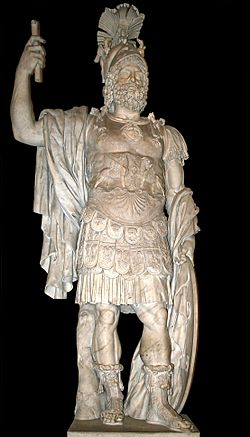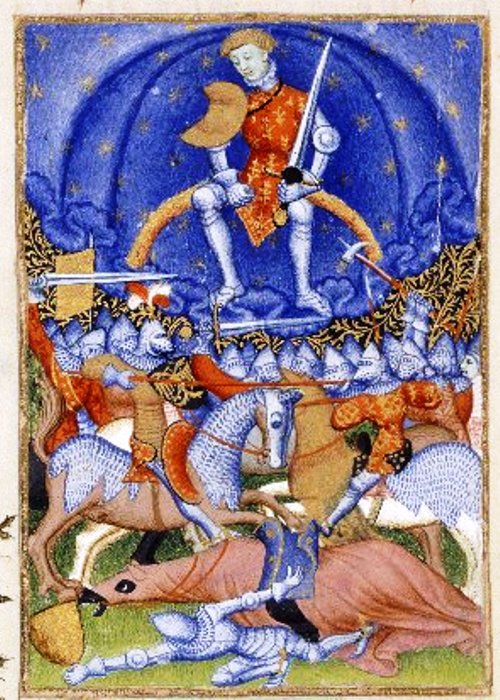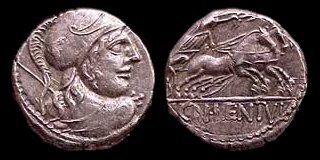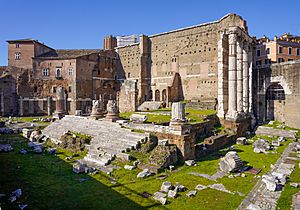Mars (mythology) facts for kids
Quick facts for kids Mars |
|
|---|---|
| God of war, guardian of agriculture and the Roman people | |
| Member of the Dii Consentes | |

Statue of Mars from the Forum of Nerva, 2nd century CE
|
|
| Other names | Mavors, Mavorte (archaic, poetic) |
| Planet | Mars |
| Symbols | spear, shield |
| Day | Tuesday (dies Martis) |
| Festivals | February 27, March 14 Equirria horse races March 1 Dies natalis (birthday) and feriae of the Salian priests March 17 Agonia May 14 dies natalis, Temple of Mars Invictus October 15 October Horse sacrifice October 19 Armilustrium |
| Personal information | |
| Consort | Nerio and others including Rhea Silvia, Venus, Bellona |
| Children | Cupid |
| Parents | Jupiter and Juno |
| Siblings | Vulcan, Minerva, Hercules, Bellona, Apollo, Diana, Bacchus, etc. |
| Greek equivalent | Ares |
| Norse equivalent | Tyr |
| Etruscan equivalent | Maris, Laran |
In ancient Roman religion and myth, Mars (Latin: Mārs) was the god of war. He was the son of Jupiter and Juno. Most of his festivals were held in March, the month named for him (Latin Martius), and in October, the months which traditionally began and ended the season for both military campaigning and farming.
Mars was identified with the Greek god Ares, whose myths were reinterpreted in Roman literature and art under the name of Mars.
Unlike Ares, who was viewed primarily as a destructive and destabilizing force, Mars represented military power as a way to secure peace, and was a father (pater) of the Roman people.
Contents
Birth
Like Ares who was the son of Zeus and Hera, Mars is usually considered to be the son of Jupiter and Juno. In Ovid's version of Mars' origin, he was the son of Juno alone.
In the earliest Roman calendar, March was the first month, and the god would have been born with the new year.
Consort
The consort of Mars was Nerio or Neriene, "Valor." She represents the vital force (vis), power (potentia) and majesty (maiestas) of Mars. Her name was regarded as Sabine in origin and is equivalent to Latin virtus, "manly virtue" (from vir, "man").
Venus and Mars
The union of Venus and Mars held greater appeal for poets and philosophers, and the couple were a frequent subject of art.
Scenes of Venus and Mars in Roman art may imply marriage, and the relationship was romanticized in funerary or domestic art in which husbands and wives had themselves portrayed as the passionate divine couple.
In ancient Roman and Renaissance art, Mars is often shown disarmed and relaxed, or even sleeping.
Sacred animals

The wild animals most sacred to Mars were the woodpecker and the wolf, which in the natural lore of the Romans were said always to inhabit the same foothills and woodlands.
Plutarch notes that the woodpecker (picus) is sacred to Mars because "it is a courageous and spirited bird and has a beak so strong that it can overturn oaks by pecking them until it has reached the inmost part of the tree." As the beak of the picus Martius contained the god's power to ward off harm, it was carried as a magic charm to prevent bee stings and leech bites.
The woodpecker was revered by the Latin peoples, who abstained from eating its flesh. It was one of the most important birds in Roman and Italic augury, the practice of reading the will of the gods through watching the sky for signs.
Mars's association with the wolf is familiar from what may be the most famous of Roman myths, the story of how a she-wolf (lupa) suckled his infant sons when they were exposed by order of King Amulius, who feared them because he had usurped the throne from their grandfather, Numitor. The woodpecker also brought nourishment to the twins.
The wolf appears elsewhere in Roman art and literature in masculine form as the animal of Mars. A statue group that stood along the Appian Way showed Mars in the company of wolves. At the Battle of Sentinum in 295 BCE, the appearance of the wolf of Mars (Martius lupus) was a sign that Roman victory was to come.
In Roman Gaul, the goose was associated with the Celtic forms of Mars, and archaeologists have found geese buried alongside warriors in graves. The goose was considered a bellicose animal because it is easily provoked to aggression.
Temples and topography in Rome
The earliest center in Rome for cultivating Mars as a deity was the Altar of Mars (Ara Martis) in the Campus Martius ("Field of Mars") outside the sacred boundary of Rome (pomerium).
The main Temple of Mars (Aedes Martis) in the Republican period also lay outside the sacred boundary and was devoted to the god's warrior aspect. It was built to fulfill a vow (votum) made by a Titus Quinctius in 388 BCE during the Gallic siege of Rome. The founding day (dies natalis) was commemorated on June 1, and the temple is attested by several inscriptions and literary sources. The sculpture group of Mars and the wolves was displayed there. Soldiers sometimes assembled at the temple before heading off to war, and it was the point of departure for a major parade of Roman cavalry held annually on July 15.
A temple to Mars in the Circus Flaminius was built around 133 BCE, funded by Decimus Junius Brutus Callaicus from war booty. It housed a colossal statue of Mars and Venus.
Iconography and symbol
 In Roman art, Mars is depicted as either bearded and mature, or young and clean-shaven. He often wears a helmet or carries a spear as emblems of his warrior nature. Mars was among the deities to appear on the earliest Roman coinage in the late 4th and early 3rd century BCE.
In Roman art, Mars is depicted as either bearded and mature, or young and clean-shaven. He often wears a helmet or carries a spear as emblems of his warrior nature. Mars was among the deities to appear on the earliest Roman coinage in the late 4th and early 3rd century BCE.
The spear of Mars
The spear is the instrument of Mars in the same way that Jupiter wields the lightning bolt, Neptune the trident, and Saturn the scythe or sickle. When Mars is pictured as a peace-bringer, his spear is wreathed with laurel or other vegetation, as on the Ara Pacis or a coin of Aemilianus.
Festivals and rituals
The festivals of Mars cluster in his namesake month of March (Latin: Martius), with a few observances in October, the beginning and end of the season for military campaigning and agriculture. Festivals with horse racing took place in the Campus Martius. Some festivals in March retained characteristics of new year festivals, since Martius was originally the first month of the Roman calendar.

- February 27: Equirria, involving chariot or horse races;
- March 1: Mars's dies natalis ("birthday"), a feria also sacred to his mother Juno;
- March 14: a second Equirria, again with chariot races;
- March 14 or 15: Mamuralia, a new year festival when a figure called Mamurius Veturius (perhaps the "old Mars" of the old year) is driven out;
- March 17: an Agonalia or Agonium Martiale, an obscure type of observance held at other times for various deities;
- March 23: Tubilustrium, a purification of the deploying army March 23;
- October 15: the ritual of the October Horse, with a chariot race and Rome's only known horse sacrifice;
- October 19: Armilustrium ("purification of arms").
Mars was also honored by chariot races at the Robigalia and Consualia, though these festivals are not primarily dedicated to him. From 217 BCE onward, Mars was among the gods honored at the lectisternium, a banquet given for deities who were present as images.
Roman hymns (carmina) are rarely preserved, but Mars is invoked in two. The Arval Brothers, or "Brothers of the Fields," chanted a hymn to Mars while performing their three-step dance. The Carmen Saliare was sung by Mars's priests the Salii while they moved twelve sacred shields (ancilia) throughout the city in a procession. In the 1st century AD, Quintilian remarks that the language of the Salian hymn was so archaic that it was no longer fully understood.
On the calendar
Mars gave his name to the third month in the Roman calendar, Martius, from which English "March" derives. In the most ancient Roman calendar, Martius was the first month. The planet Mars was named for him, and in some allegorical and philosophical writings, the planet and the god are endowed with shared characteristics. In many languages, Tuesday is named for the planet Mars or the god of war: In Latin, martis dies ("Mars's Day"), survived in Romance languages as marte (Portuguese), martes (Spanish), mardi (French), martedì (Italian), marți (Romanian), and dimarts (Catalan). In Irish (Gaelic), the day is An Mháirt, while in Albanian it is e Marta. The English word Tuesday derives from Old English "Tiwesdæg" and means "Tiw's Day", Tiw being the Old English form of the Proto-Germanic war god *Tîwaz, or Týr in Norse.
Images for kids
-
A relief depicting Mars and Venus on a black-slip bowl from Campania, Italy, 250–150 BCE, British Museum
-
She-wolf and twins Romulus and Remus from an altar to Venus and Mars
-
Denarius, issued 88 BCE, depicting the helmeted head of Mars, with Victory driving a two-horse chariot (biga) on the reverse
-
The so-called Mars of Todi, an Etruscan bronze of the early 4th century BCE, probably depicting a warrior
-
Mars celebrated as peace-bringer on a Roman coin issued by Aemilianus
-
A statue to Mars Ultor from Balmuildy on the Antonine Wall has been scanned and a video produced.
-
Fragmentary dedication stele to Mars Augustus from Roman Gaul
See also
 In Spanish: Marte (mitología) para niños
In Spanish: Marte (mitología) para niños












